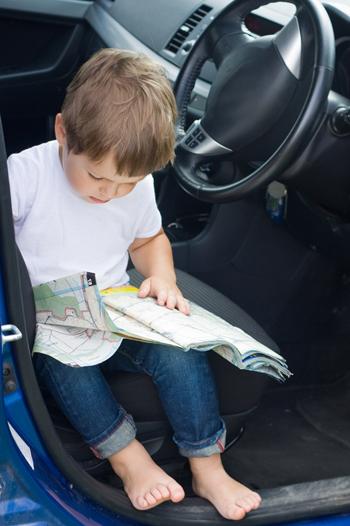Reading a map
Duration/age

Before leaving the house to travel somewhere find your location on a map and identify where you want to go. Plot the best route to travel to that location.
Will the route you take change if you are walking or travelling in a car or a bus? Talk about the number of streets you may need to cross and if the streets are long or short. Is the location you are travelling to close or far away? When looking at the map can you also identify other symbols on the map to show different landmarks.
Materials you will need
- Street directory
- Map
Alternative tools
- Online maps
Skills this activity improves
Why does this matter?
Reading a map helps children to understand and interpret different representations of position and location and how to orient and navigate themselves within the environment. Looking at symbols helps children to understand and interpret patterns. It also helps them to understand that data can be presented using different visual symbols.
What does this lead to?
Reading and interpreting a map helps children develop an understanding that there are different ways we can move around within space and that having an understanding of symbols, measurement, and direction will help us to make sense of a map.
Language to use
- Map, street directory
- Turn, left, right
- Over, under
- Stop, start, go, wait
- Long, short, narrow
- Curved, bend, straight
- Street, road, river, railway, park
Questions to use
- Which direction should we go?
- Will we travel a different way if we walk instead of travelling in the car?
- Are all the streets the same?
- What are the symbols on the map?
- What could the large green spaces be?
Useful tips
- You might also want to look at the Treasure hunt activity.
- Remember to talk to your child in your home language.
More ideas
- Create a map of your house.
- Create a treasure map.
- Plot the route that you will travel around a shopping centre to find all of your groceries.
Variation by age
Three to five year olds
- Create a treasure hunt. Hide things around the house and then have your child find them from the map.
- Draw a map of your child’s bedroom and together look at how you could rearrange the furniture.
- Write a list of the different places you need to go each day and plot which direction and order you will do the jobs in.
- Set up a city of blocks, including roads, cars, road signs and plants.
- Make a train track.
- Read the story, or listen to the story on Play School, of “We’re Going on a Bear Hunt” by Helen Oxenbury and Michael Rosen.
Questions to ask
- What can fit in this space if we moved the furniture?
- Which direction will we go?
- Where do we need to go first and then where next?
- What do the symbols mean?


